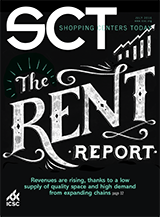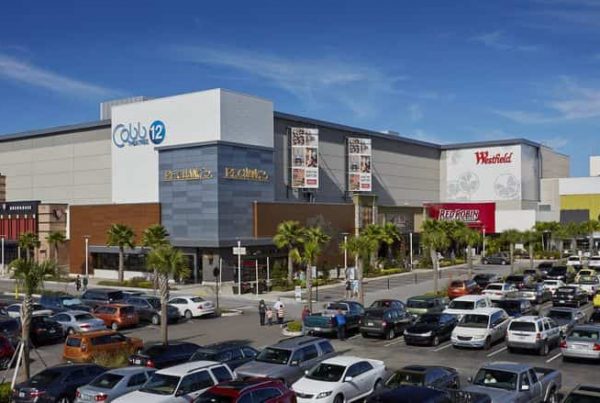Strong demand and restrained construction are driving up shopping center revenues
by Joel Groover
Shopping Centers Today, July 2016
Headlines sound the drumbeat about “the death of the American mall” and the crushing effect of the Internet on brick-and-mortar stores. And yet those who study the actual performance of retail properties tell quite a different story, one of robust performance. “Space demand will once again exceed supply this year, supporting a 30-basis-point decline in vacancy to 5.9 percent, the lowest year-end level in 16 years,” write Marcus & Millichap researchers in a report. “Tighter vacancy will underpin rent gains of 2.8 percent, the largest rent appreciation since 2007.”
According to a JLL analysis of asking rents for the top U.S. retail markets, the weighted average rose from $15.09 per square foot at the end of the first quarter of 2013 to $15.93 at the close of the first quarter of this year. “Overall, rent has certainly recovered, especially if you’re talking about prime retail corridors and class ‘A’ malls,” said James Cook, JLL’s director of retail research. “Vacancies have been continuing to decline at grocery-anchored and nonanchored centers as well. Why? Because the economy continues to grow slowly, and we don’t have a lot of new construction coming online.”
Developers have delivered about 50 million square feet of new supply across the country over the past five years, according to Bill Rose, national director of Marcus & Millichap’s retail group. But most of this new construction has focused on net-leased, stand-a-lone banks and restaurants rather than multitenant retail centers, he says. “It has not been the bug wave of mall construction like we experienced in the 1970s and ’80s,” Rose said. “So vacancies are coming down in many major metros, which certainly gives landlords more opportunity to raise rents and push values.” Healthy retailers have also shored up their balance sheets and shifted into expansion mode to capitalize on the recovery, Rose says. “People are actively consuming, so it makes perfect sense that retailers can now afford to operated under increased rent levels,” he said.
But comparing the retail sector today to what it was before the recession can be misleading, experts say. To be sure, rents and occupancies at many mall companies are healthy. In Simon’s portfolio, occupancy stood at 95.6 percent at the end of the first quarter, with average sales per square foot standing at $613. In the General Growth Properties portfolio, same-store occupancy was at 95.9 percent, meanwhile, with rental rates on newly signed leases up by 13 percent from the 12 months previous, according to a press release, “Malls have been really strong,” says Jeff Havsy, chief economist at CBRE Econometrics Advisors. “That’s where we have seen tremendous growth, and it may be one of the reasons we’re seeing these new highs.”
Nonetheless, mall REITs, which have been selling underperforming assets for years, continue to push properties off their balance sheets. Back in April 2007 Simon owned outright or held interests in 382 properties globally. As of last December, that had shrunk to 225. Thus, though mall REITs are posting healthy numbers, they are doing so by means of much leaner operations. Meanwhile, the landlords of lower-tier malls in secondary and tertiary markets continue to face challenges. “It’s really across the board,” Havsy said. “You have parts of the retail spectrum that are just blowing the doors off – they have great rent growth and low vacancy – but if you own a “C” mall, you might be thinking about repurposing.”
Fortunes also vary widely by market, a dynamic that became even more pronounced in the aftermath of the 2008 crash. “Following the recession, we saw several markets that never dipped all that significantly and were on their way to growing just a year after the downturn, or even earlier,” said Todd M. Caruso, senior managing director of CBRE’s retail owner/agency practice in the Americas. “So in a market like Washington D.C., you never really had a significant setback. In Phoenix or Las Vegas the setbacks were significant.” Retail performance recovered quickly in global gateway cities such as Chicago, New York and San Francisco, but the lag for other parts of the country was such that it took six or seven years for positive rent growth to return in the aggregate, Caruso notes. “You hear about rents of $4,000 a square foot on Fifth Avenue,” he said. “But remember that there are large REITs that own grocery-anchored or community centers across the United States where average base rents are still under $20.”
Jonathan Lapat, a principal of Framingham, Mass.-based Strategic Retail Advisors, part of brokerage network X Team International, cites record-breaking rents in Boston’s Back Bay neighborhood, known for its rows of Victorian-era brownstones and for such attractions as Copley Place and the Boston Public Library. Rents have also soared in and around Seaport Square, the 6.3 million-square-foot, master-planned development of Boston Global Investors, Morgan Stanley and WS Development, he says. The project hinges on turning 23 acres of former parking lots into a live-work-play community. “Some of the rents in that market, where there is absolutely zero existing retail, are north of $100 a foot,” Lapat said. “There is no historical context for this.”
According to Marcus & Millichap, other top U.S. markets besides Boston include the four tech-driven cities – San Francisco; Seattle; Austin, Texas; and San Jose, Calif. – as well as Miami, San Diego, New York City and parts of Orange County, Calif. In exclusive areas such as Boston’s Back Bay, asking rents may already be close to their upper limits, Lapat says.
But while performance clearly is strongest in major metros, the healthier economy is also conferring broad-based benefits to retailers and landlords across the country, observers say. Throughout the last year the recovery drove respectable sales growth in retail categories such as sporting goods, home improvement, furniture and apparel, and many chains are well positions to keep on growing for the rest of the year, according to Marcus & Millichap. Employment trends, too, are promising. “Following the addition of 2.7 million jobs in 2015, employers will maintain the steady pace of growth by creating another 2.5 million positions this year,” Marcus & Millichap researchers write in their outlook for 2016. “Secondary and tertiary metros were late to join the economic recovery but will record solid hiring gains in 2016.”
At the property level, some of today’s performance strength can be credited to ways savvy owners and managers have adapted to change, according to Rachel Elias Wein, president of WeinPlus, a St. Petersburg, Fla. – based real estate strategy consulting firm. In particular, she cites tenant mixes centered on Internet-resistant retailers with broad demographic appeal. “The Sembler Company, for example, has strategically adjusted its portfolio over the past five to seven years to focus on tenants in health, beauty, wellness and fitness,” Wein said. “Sembler now has far fewer traditional retailers – concepts where you walk in, buy something and go home – and is seeing a lot of success with its tenanting strategy.”
But what about troubling retail news, such as the lackluster earnings of J.C. Penny, Kohl’s, Macy’s and Nordstrom, or the bankruptcy of Aeropostale, Pacific Sunwear, Sports Authority or Wet Seal? In fact, store closures are rampant, hitting highs unseen since 2010, according to Cushman & Wakefield. “Chains as diverse as American Eagle, JoS. A. Bank, Aeropostale, Kohl’s, Stage Stores and other retailers returned hundreds of locations to the marketplace in Q1 2016,” write researchers in one of the firm’s retail updates. Some in the media attribute this to competition from e-commerce, but others, Lapat among them, offer a more conservative interpretation. “To me, most of this is just the natural lifecycle of retail,” he said. “That there are some struggles out there in retail should not, in and of itself, be overplayed. The key it to understand the broader trends.”
Often overlooked among those broader trends is the struggle of the American middle class, observers say. According to a survey published in May by the Associated Press and a public-affairs research firm, two-thirds of Americans are so cash-strapped that they would have trouble covering even a $1,000 emergency. The poll of roughly 1,000 respondents suggest that this holds true even among many with annual household incomes between $50,000 and $100,000. “The struggle of the middle class explains a lot of the issues with middle-market retailers right now,” Cook said. “Luxury chains are still performing well, and discounters are going like gangbusters. The softness is in mass merchandisers going for that traditionally middle-class consumer.”
Having learned to pull in their purse strings during the recession, middle-class shoppers still gravitate toward off-price options like Ross Dress for Less and T.J.Maxx or hunt for bargains at discount-oriented, fast-fashion chains such as Irish clothing retailer Primark, Cook says. He cites Primark’s June 10 opening in a former Sears box at Pennsylvania’s King of Prussia Mall. “This really exemplifies the shift,” Cook said. “Today people want to buy large amounts of inexpensive goods that, while they aren’t necessarily all that well made, are fashion-forward.”
Despite these concerns about the middle class, many landlords still find that their properties’ parking lots and retail spaces are full or nearly so, and that rents are once again healthy, Wein says. Complacency is a danger during such good times, she says. “It could be easy to say, ‘Our portfolio is 97 or 98 percent leased, and we’re going to sit back and enjoy this,'” Wein said. “But when you have a stable portfolio and it is more of a landlord’s market, that’s a strategic opportunity. You have the time and resources to gauge how efficiently your business is operating, determine where the market will be in the next 24 or 36 months and start planning for that eventuality. If you wait until a crisis emerges, it will be too late.”
Marcus & Millichap is predicting restrained retail-property development for the rest of the year – about 46 million square feet of new supply – but also notes that the number of new projects in the pipeline continues to grow. This is especially so in fast-growing Chicago, Dallas-Fort Worth, Houston, New York City, and Orlando, Fla., the firm reports. The rising demand for space, along with the low cost of capital, could lead to overbuilding, says Rose. “As long as we maintain a nice equilibrium between demand and new deliveries, we should be in good shape,”Rose said. “We have to be mindful of any cycle of overbuilding where too many in the industry start to say, “Great, let’s respond by building up a lot of new projects.’ That could cause a stall in these improving fundamentals.”
A recession would also threaten those fundamentals, of course. Some analysts, noting that the seven-year-old expansion is already the fourth longest in 150 years, cite the risk of a slowdown in the years ahead. “In our model at JLL, we are expecting a mild recession on the horizon, not next year but perhaps in two years,” Cook said. “But overall, we’re going to see vacancies continue to decline and rents continue to rise at a slow but steady pace.”









